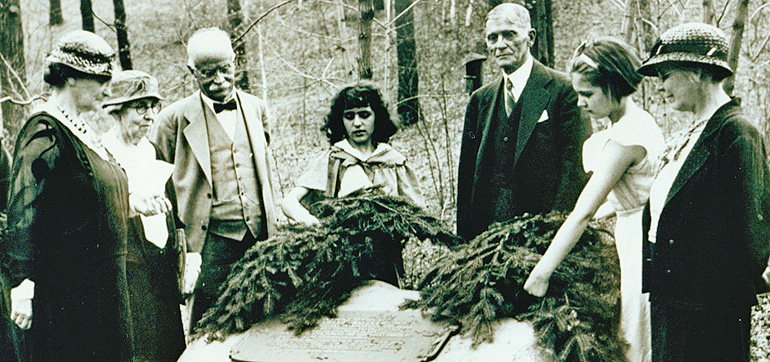
1934 History
of the Eloise Butler Wildflower Garden

1934 was Martha Crone's 2nd year in charge of the Garden, which now began its 28th year.
What the Garden Curator called “an unprecedented drought” in 1933, was to lead to much plant damage in the coming spring of 1934. Although that season was not as stressful as the later 1958-1959 winter it is likely that the lack of snow during the winter of 1933-’34 and unusually warm January temperatures which caused a day-night freeze-thaw cycle, was the prime causes of the plant loss that was only noticed in the spring. The snow depth in December and January rarely exceeded 4 inches and due to the well above average temperatures in January there was no snow cover in February and March 1934. Martha Crone's position this year would continue be "temporary" Curator of the Garden. (1)
Preliminary notes about the plants. Native Status: Some of the plants obtained by Eloise Butler in the early years of the Garden were not native to Minnesota or if native, may have been difficult to establish in the Garden. Most of these are no longer present. Martha Crone was somewhat more selective of native plant material, but also brought in many species not native to the State, and many of her imports have not survived either. The plants illustrated here, so one can see what they looked like, are mostly of the class no longer extant in the Garden. Some of those plants still existed at the time of Martha Crone's 1951 Garden Census and they are identified by the "(M.C.)" following the plant name. As for plants mentioned here that are still present in the Garden today, there may have been numerous re-plantings, and most have a web link to a detailed information/photo page, or, if not, are noted as being extant - these are not illustrated in this article. Botanical classification: Over the years Botanists have reclassified many plants from the classifications in use at the time Eloise Butler wrote her Garden Log or when Martha Crone prepared her census. I have retained the nomenclature that Eloise Butler or Martha Crone used and then provided the more current classification as used by the major listings in use today, particularly Flora of North America and the Checklist of the Vascular Flora of Minnesota from the University of Minnesota Herbarium.
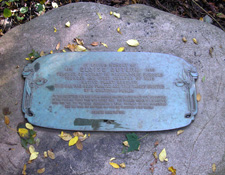
Martha opened the Garden on April 1st with 2 inches of snow on the ground. Heavy rain on April 5th washed out the Garden paths and by the 8th the last ice melted in the wetland pools. Snow Trillium bloomed on the 9th. The warmer weather of February and March was not to last into April. The month turned very cold. She reported that all plant growth was retarded due to extreme cold, with ice forming on the ponds each day. On the 21st water froze in the office and again on the 27th, with 1/2 inch of ice on the ponds. In spite of this the Bloodroots bloomed on the 24th. Then the weather abruptly changed. The next day the temperature reached 87 degrees followed by 90 degrees on the 29th.
Martha reported that the unprecedented drought of 1933 had wiped out the entire supply of Showy Orchids, Shooting Star and some varieties of Ferns. She reported that other showy plants took their place.

On the 23rd of April a fire occurred on the west boundary where a small wooden building burned. Martha shouted for help from anybody nearby and the damage within the garden itself was limited. Martha logged some replanting later in the season in the fire damaged area “Near the Mayapple” which is curiously close to the area of Eloise Butler's “Pinetum” that was damaged by fire in 1910.
On May 4th a bronze tablet in honor of Eloise Butler was dedicated. Eloise had died the previous spring. It is mounted on a large boulder that sits in front of the current Martha Crone Visitors Shelter. The cost of fabrication was paid by a group of Miss Butler’s former pupils and her friends. Details on the tablet and dedication.
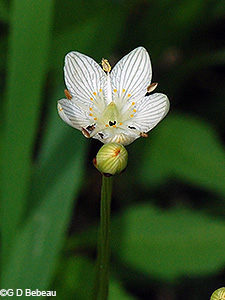
The heat wave continued in May. On the day of dedication of the tablet the Garden was very parched. Nationally, this was the dust bowl era. May in Minneapolis was the warmest in history, with a temperature of 106 degrees on May 31st and no rain, dust on everything. The ferns were drying to a crisp. Still, Martha reported that the birds were nesting and laying eggs and she was able to bring in new plants among which were a number of violets and Lady’s-slippers, especially the Small White Lady’s-slipper (Cypripedium candidum) of which she planted 41 from a source at Twin Lake.
Early Plantings, some with questionable names and some not present today (see notes at top of page and immediately below):
Species Notes: Like Eloise Butler, Martha also kept a Garden Log of her planting and from this log we can note plants where the year 1934 is her first reference to them. Here is a listing of most of those first-listed plants. In first position are the common and botanical names that she used; these are followed by other common names for the same plant and the newer botanical classifications, if any. Plant sources are Minnesota sources and the plants are native to the State

- Grass of Parnassus, (M.C.); (Parnassia caroliniana); The botanical name Martha listed is not native to Minnesota, yet she lists her source as Twin Lake (in the metro area). In 1908 Eloise Butler first noted in her Garden Log the observance of Grass of Parnassus growing in the Garden. She used this same botanical name. We can discount that a species native only to the temperate East Coast would be growing here. It is noted in Flora of North America Volume 12, that P. caroliniana has been misapplied to P. glauca (which is native to this area) in early references such as Britton, N.L., and A. Brown. 1913. An illustrated flora of the northern United States, Canada and the British Possessions. 3 vols. Charles Scribner's Sons, New York.
- Hand-leaf Violet (Prairie Violet), (M.C.); (Viola palmata - most likely Viola palmata var. pedatifida. There are a number of varieties of V. palmata. Martha does not specify but only lists the common name “hand-leaf” which is not a current term. As her source was Long Lake MN, we suspect that she obtained the Prairie Violet which is native to that area of the state and is the only variety of V. palmata listed on the Checklist of the Vascular Flora of Minnesota.
- Prickly Pear (Devil's tongue), (M.C.); (Opuntia rafinesquii -now- Opuntia humifusa) - planted May 24th and Martha noted beautiful blooms on June 10th.
Martha also planted species that are still represented in the Garden today, including:
Bloodroot, Jack-in-the-Pulpit, Snow Trillium, Wooly Blue Violet, White Trout-lily and Greater Yellow Lady’s-slipper and Arrow-leaf Violet; (Viola sagittata -now- Viola sagittata).
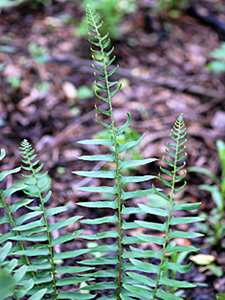
Martha Crone reported that the number of bird students visiting the Garden had greatly increased “due to the large number of birds that nest here attracted by the natural water supply and food and feeling free from molestation.” Dr. Thomas Roberts (author of Birds of Minnesota and for whom the Roberts Bird Sanctuary is named), after he had conducted his bird class through the Garden presented to the Garden a set of colored bird plates for display on the walls of the Garden office (which Martha refers to as a “cabin”). These may have been reproductions of some of the plates used in his 2-volume book, originally published in 1932.
In August, Gertrude Cram was again vacationing on Isle Royal and sent a package of collected plants back to Martha at the Garden, including Fireweed. She wrote:
"I found a clump of seedlings of Fireweed of which I dug some. Miss Butler said nothing would ever induce it to grow for her but I thought you might like to make another attempt. I am going to bring a few of the seedlings for my Garden. We'll see who has success, I have tried seeds and plants before and got nothing." (2).
Daily temperatures ran above average during the summer until late August, then there was a pronounced cooling. June 27th was another record breaker at 104 degrees and over July 21 to 23 there were three days above 104 degrees.
Fortunately for the Garden, rains occurred during the summer months and began to end what had been a multi-year period of dryness although Martha reported that the "drinking spring" dried up on July 2nd. This may have been the Great Medicine Spring outside the Garden where people came for water, or the Spring behind the Garden back gate known as the “Bubbling Spring.”
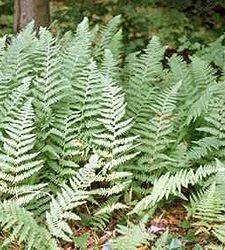
Early Plantings not present today (see notes at top of page and the “Species Notes” in the Spring section). Except for the Corydalis, all were previously in the Garden during Eloise Butler's time:
- Azure Bluets; (M.C.), (Houstonia caerulea); this is not native to the State. Her source was frequent Garden visitor Mr. Burgess who may have obtained it elsewhere.
- Common wormwood, (M.C.); (Artemisia absinthium). This is an introduced plant and naturalized across most of the United States.
- Creeping Snowberry, (M.C.); (Chiogenes hispidula -now- Gaultheria hispidula)
- Honeysuckle, (M.C.); (Lonicera) - no species mentioned although two years later she would bring in Lonicera caerulea, Blue Honeysuckle.
- Threeleaf goldthread, (M.C.); (Coptis trifolia) Photo below.
- Yellow Corydalis (yellow fumewort), (Corydalis flavula); this is not native to the State. Her source was Mr. Burgess, so we don't know where he got them. (note 3)

Martha was a great lover of ferns and after 1933 when she assumed the Curator position she included ferns in her plantings. In 1934 she brought these in for the first time in her tenure (four are still considered extant):
- Bladder Fern (Bulblet Bladder Fern), (M.C.); (Cystopteris bulbifera). Extant.
- Brittle Bladder Fern (Fragile Bladder Fern), (M.C.); (Cystopteris fragilis). Extant.
- Christmas Fern, (M.C.); (Polystichum acrostichoides). This fern is quite rare in the wild and is on the Minnesota “Threatened” list. The only native populations recorded were in Houston and Winona counties. Extant. Her source was Mr. Burgess who got them from the Ferndale Nursery in Askov MN.
- Hay-Scented Fern (Eastern Hay-scented), (M.C.); (Dicksonia punctilobula). Not native to Minnesota. Her source was Mr. Burgess.
- Marginal Wood Fern (Marginal Shield Fern), (M.C.); (Dryopteris marginalis). Extant. Her source was Mr. Burgess.
- Walking Fern; (M.C.), (Camptosorus rhizophyllus -now- Asplenium rhizophyllum). Somewhat rare as it is native only to the SE Corner of the State. Her source was Mr. Burgess who obtained them at Winona.
Some of the plants Martha planted during the summer months are still in the Garden today in about the same places. These include:
Blue Jacket, Cardinal flower, Fireweed, Great St. Johnswort, Hepaticas, White Trillium,Queen of the Meadow, Greater Yellow Lady’s-slipper, Sweet Fern and Tamaracks (that she obtained from the quaking bog). Pale Corydalis, also planted, is no longer extant.

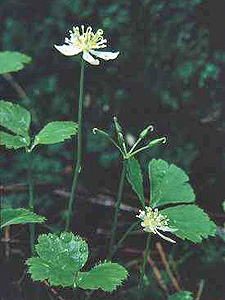

Early Plantings not present today (see notes at top of page and the “Species Notes” in the Spring section):
- Blueberry (Low-bush Blueberry), (M.C.); (Vaccinium pennsylvanicum [this should be “pensilvanicum”] -now- Vaccinium angustifolium)
- Fringed Gentian, (M.C.); (Gentiana crinita -now- Gentianopsis crinita)
- Smaller (Lesser) Fringed Gentian, (M.C.); (Gentiana procera -now- Gentianopsis virgata ssp. virgata).
- Lesser Purple Fringed Orchid, (M.C.); (Habenaria psycodes -now- Platanthera psycodes)
- White Water-lily, (M.C.); (Castalia odorata -now- Nymphaea odorata ssp. odorata).
The Fringed Gentians were obtained In September, some from a source in Ramsey County and some from Turtle Lake. This plant she called “one of the wildest, as well as one of the most charming wildlings.” She was going to attempt to germinate seeds the following winter. (Ed. note: The Fringed Gentian has been very difficult to maintain in the Garden. It has been tried a number of times, all unsuccessful in the long run). Gentiana crinita became, in later years, an emblem of The Friends of The Wild Flower Garden when The Friends named their newsletter The Fringed Gentian™.
Some of the plants Martha planted during the fall months are still in the Garden today include:
Sky Blue Aster, Smooth Blue Aster.
A large Polyporus fronds mushroom appeared on September 1st at the base of a large oak and she took it the state fair where it weight 9 lbs. (The following year a 25 pound'er would be produced at the same tree).
Martha's planting in the Garden totaled 996 plants during 1934 including, in October, 36 small Kentucky Coffeetree (Gymnocladus canadensis), obtained from New Ulm. She heeled them in for transplanting the following spring. A number of these trees still are present in the Woodland Garden today. Note: 25 years earlier, Eloise Butler had also planted some Kentucky Coffeetree.
Final Report for the year:
In her Annual Report to the Board of Park Commissioners dated November 27, 1934, Martha reported that the total plantings for the year comprised 97 species representing 67 genera and 39 families. Martha closed the Garden on Sunday September 30th amid beautiful weather and bright fall foliage.
Daily temperatures in October and November were above average, but with good precipitation through the end of the year. Snow depth in December averaged about 6 inches.

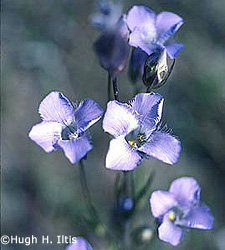
Notes from the text:
Note 1: Martha was appointed "temporary" Curator in April 1933 to work until Oct. 1st, 1933 for $60 per month. (Letter of Superintendent Theodore Wirth to the Board of Park Commissioners dated April 18, 1933). This was confirmed in 1936 and 1938 by the Minneapolis Civil Service Commission that her position was "temporary Curator" at the same rate of pay. It was not until April 4, 1940 that the position was confirmed permanent.
2: Letter from Gertrude Cram to Martha Crone posted from Isle Royal, August 1934, Martha Crone collection, Minnesota Historical Society.
3: Mr. Burgess refers to Gerald H. Burgess who was a real friend of the Garden who sourced plants for Martha Crone for a number of years in the 1930s. He was active in many associations and owner of Panama Carbon Co. He passed away on April 29, 1938 and in 1986 a memorial fountain was erected just inside the Garden front gate, in honor of him and his wife Louise. When the Martha Crone Shelter was built, Louise had provided the Friends with the first Book of Memorials that was kept in the Shelter.
4: These Kodachromes were given to Friends of the Wild Flower Garden by the Martha Crone Estate.
Historical photo at top of page - dedication of the memorial tablet for Eloise Butler - Photo courtesy Martha Crone Collection, MHS.
Printable PDF file of this page.
Links to related pages:
- Abbreviated Life of Eloise Butler
- Martha Crone - 2nd Garden Curator
- Ken Avery - 3rd Curator and Gardener
- Cary George - 4th Gardener
- Our Native Plant Reserve - Short document on the origins of the Garden.
- Eloise Butler's writings, a selection of essays written by Eloise Butler on the early Garden years.
- Geography of the Garden- an illustrated tour
Other References:
(1) Garden Log - Native Plant Reserve, Glenwood Park, Minneapolis, MN by Eloise Butler
(2) Martha Crone's Garden Log and her 1951 Census of plants in the Garden.
(3) Martha Crone's Annual Report to the Board of Park Commissioners dated Nov. 27, 1934.
(4) Various papers and correspondence of Eloise Butler in the collection of the Minnesota Historical Society.
Historical Climatology of Minneapolis-St. Paul Area by Charles Fisk.